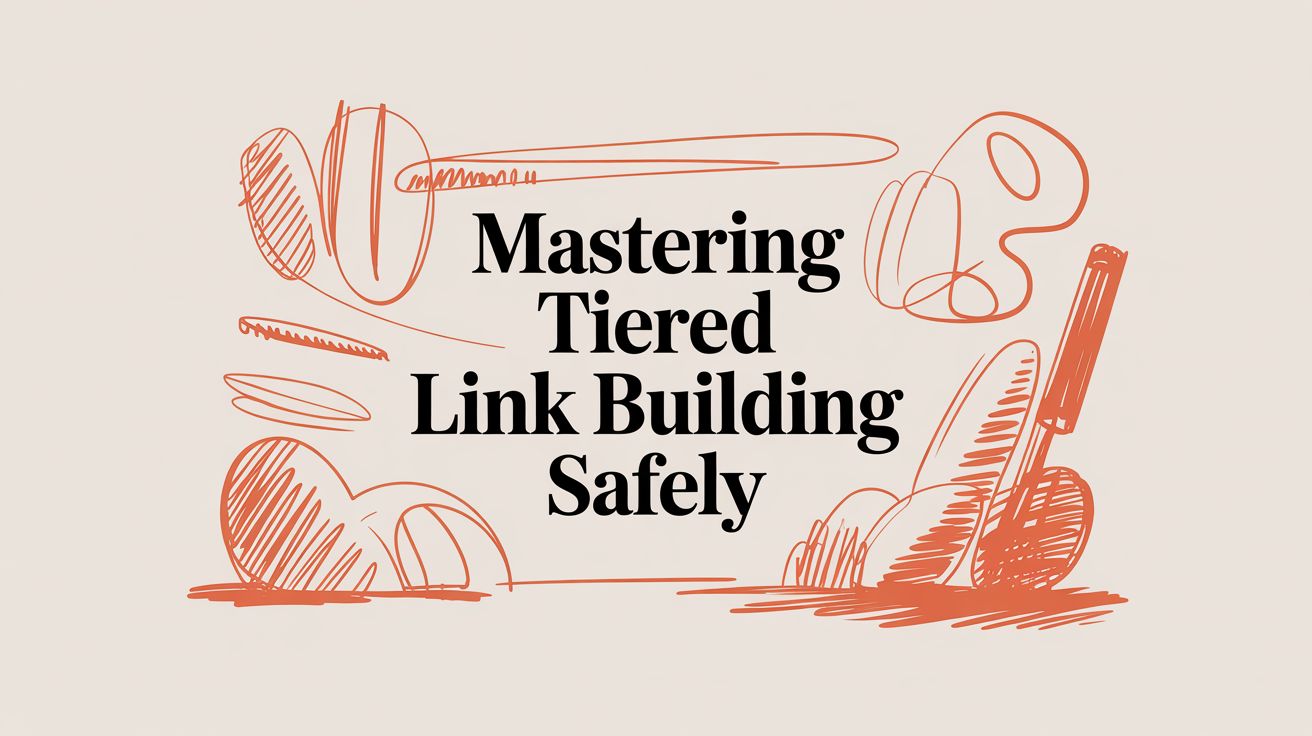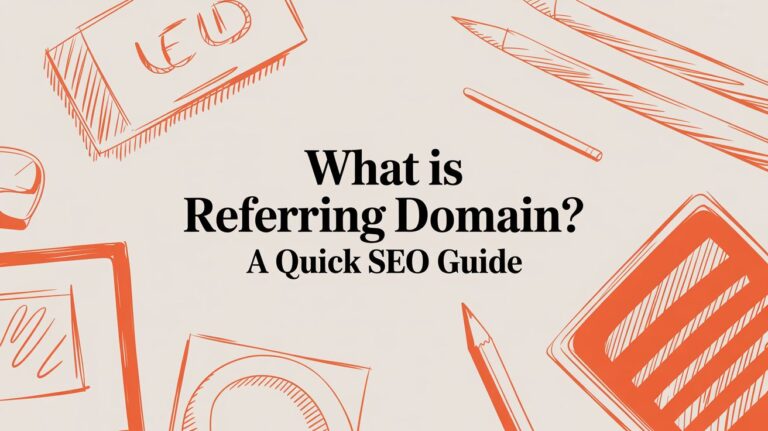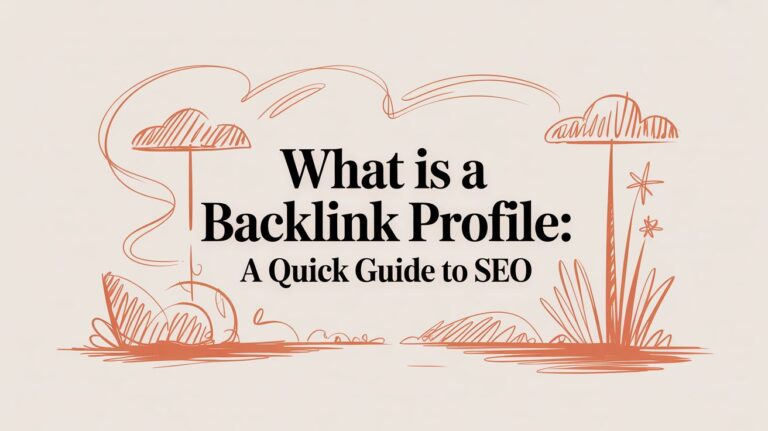Mastering Tiered Link Building Safely
Building links to your links is the core idea of tiered link building. This strategy makes your best backlinks even stronger by creating a supportive network behind them. Instead of pointing every link directly to your site, you create layers (tiers) that funnel authority upwards, boosting your most important backlinks.
What Is Tiered Link building?
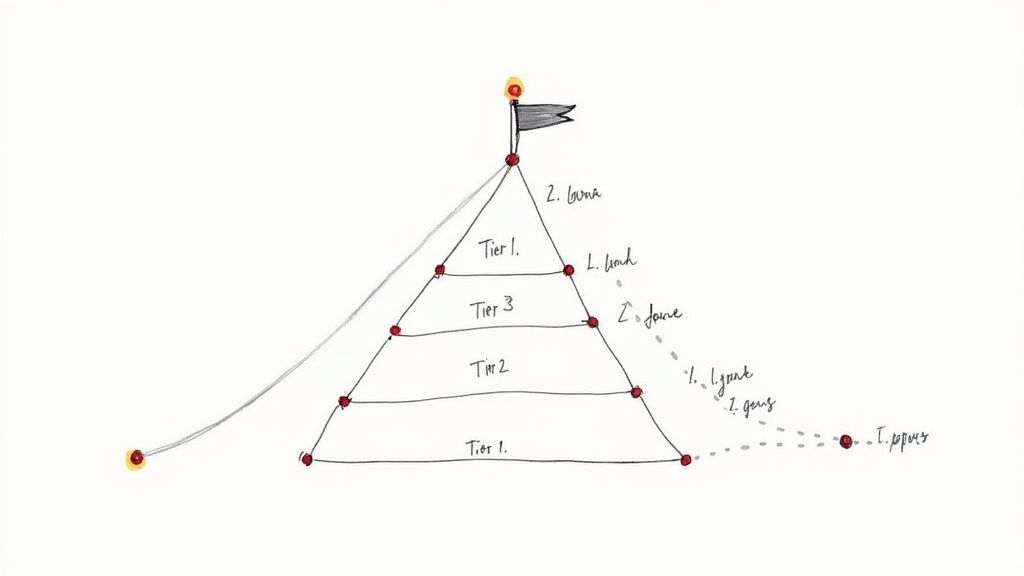
Imagine your website at the top of a pyramid. A single, high-quality backlink is a strong foundational stone. Its true power, however, comes from the layers of smaller stones supporting it. Tiered link building works the same way.
You build a strategic hierarchy that channels link equity from a wide base of links, through stronger layers, until all that concentrated power reaches your website.
The Core Structure Explained
The system is simple: build links to the pages that link to you. Most tiered structures have two or three layers, each with a specific job and quality requirement. This approach maximizes the SEO impact of your best links while shielding your main site from lower-quality links.
Let’s break down the layers:
- Your Website (The “Money Site”): This is your target, the page you want to rank. It sits at the peak of the pyramid, ready to receive amplified authority.
- Tier 1 Links: These are your best backlinks, pointing directly to your money site. They are high-quality guest posts on industry blogs or placements in respected online journals.
- Tier 2 Links: This is where the magic happens. These links point to your Tier 1 pages, not your money site. Their purpose is to make your Tier 1 links more authoritative, so they pass more power to your site.
- Tier 3 Links (and beyond): This is the base layer. These links point to your Tier 2 pages. They are typically lower-quality and created in higher volume, mainly to help get Tier 2 pages indexed.
Why This Strategy Works
Why go to all this trouble? The logic ties directly to how search engines value backlinks. A link from a page with its own strong backlink profile is far more valuable than a link from an isolated page.
By building links to your Tier 1 properties, you send a powerful signal to search engines: “This page linking to my website is a big deal.” This endorsement makes the original Tier 1 backlink exponentially more powerful.
This process lets you squeeze every drop of value out of your best links. It turns a great backlink into a supercharged SEO asset, giving you a serious advantage in competitive niches.
The Architecture of a Link Building Pyramid
A tiered link building strategy is like constructing a pyramid. Each layer has a distinct purpose and quality standard. To succeed, you need the right assets for each tier, ensuring authority flows seamlessly from the base to the top—your website.
Getting this architecture right is the first step to a campaign that drives results. You are building a stable, powerful structure, not a fragile house of cards.
Tier 1: The Apex of Quality
Tier 1 links are the crown jewels of your backlink profile. They are the only links in the pyramid pointing directly to your money site, so they must be of the highest possible quality. Think of them as the main support beams of a house; they must be strong enough to carry your SEO goals.
These links are earned through serious effort and should come from websites you’d be proud of. They must be editorially sound, relevant, and placed on domains with real authority and organic traffic.
Common examples of Tier 1 links include:
- Authoritative Guest Posts: Valuable articles published on respected industry blogs.
- Digital PR Placements: Mentions or links from news outlets or high-authority publications.
- High-Quality Niche Edits: Contextual links placed into existing, relevant articles on established sites.
The rule for Tier 1 is simple: every link should be powerful enough to stand on its own. You’re not just building links; you’re acquiring digital assets that vouch for your website’s credibility.
Tier 2: The Reinforcement Layer
Tier 2 is where amplification happens. These links do not point to your money site. Their sole job is to link to your Tier 1 pages, boosting their authority so they pass more value to your website.
Since they’re one step removed, the quality requirements are more flexible—but that never means spammy. The goal is to create a strong supporting cast that makes your Tier 1 assets look more important to search engines.
Good sources for Tier 2 links include:
- Well-Crafted Web 2.0s: Profiles and articles on platforms like Medium, Blogger, or Tumblr, filled with unique, relevant content.
- Strategic Forum Engagement: Helpful, contextual posts in niche forums that naturally link back to your Tier 1 content.
- Private Blog Network (PBN) Posts: If used, these must be high-quality, well-maintained networks that are topically aligned with your Tier 1 assets.
Tier 3: The Foundational Base
Tier 3 creates the wide, scalable foundation of your pyramid. These links are built in higher volume and their main job is to support your Tier 2 assets. They help get Tier 2 pages indexed and give them an initial push of authority that travels up the chain.
The quality standard here is the most relaxed, but “lower quality” doesn’t mean spam. Tiered link building is a popular strategy, especially in tough markets. It allows for smart risk management by keeping these lower-impact links on the bottom tiers, far from your money site. You can learn more about this strategy from these insights on tiered link building on Editorial.Link.
This foundational layer often includes:
- Blog Comments: Relevant, non-spammy comments on related blog posts.
- Social Bookmarking: Submissions to various bookmarking sites to help with indexing.
- Directory Submissions: Listings in general or niche-specific online directories.
The table below breaks down the role of each tier.
Link Types and Placement by Tier
This table offers a clear breakdown of the right link types for each level, highlighting their purpose and quality needs.
| Tier Level | Primary Purpose | Common Link Types | Quality & Relevance |
|---|---|---|---|
| Tier 1 | Pass direct authority and relevance to your website | Guest Posts, Digital PR, High-DR Niche Edits | Highest Quality, Strict |
| Tier 2 | Boost the authority of your Tier 1 links | Quality Web 2.0s, PBNs, Forum Links, Guest Posts | Medium Quality, Relevant |
| Tier 3 | Support and index Tier 2 links | Blog Comments, Social Bookmarks, Directories | Lower Quality, Broadly |
This structure ensures potent link equity flows to your site while creating a buffer that insulates you from lower-quality assets.
Navigating the Rewards and Risks
Like any advanced SEO strategy, tiered link building is a high-stakes game. Done right, it can amplify your best backlinks like nothing else. Done wrong, it can be seen as a manipulative tactic that gets you penalized by Google.
Success requires balancing the massive potential upside against the real threat of a penalty. Before you start, be clear on this dynamic and whether it aligns with your brand’s risk tolerance.
This infographic breaks down the classic pyramid, showing how authority flows from the base layers up to your money site.
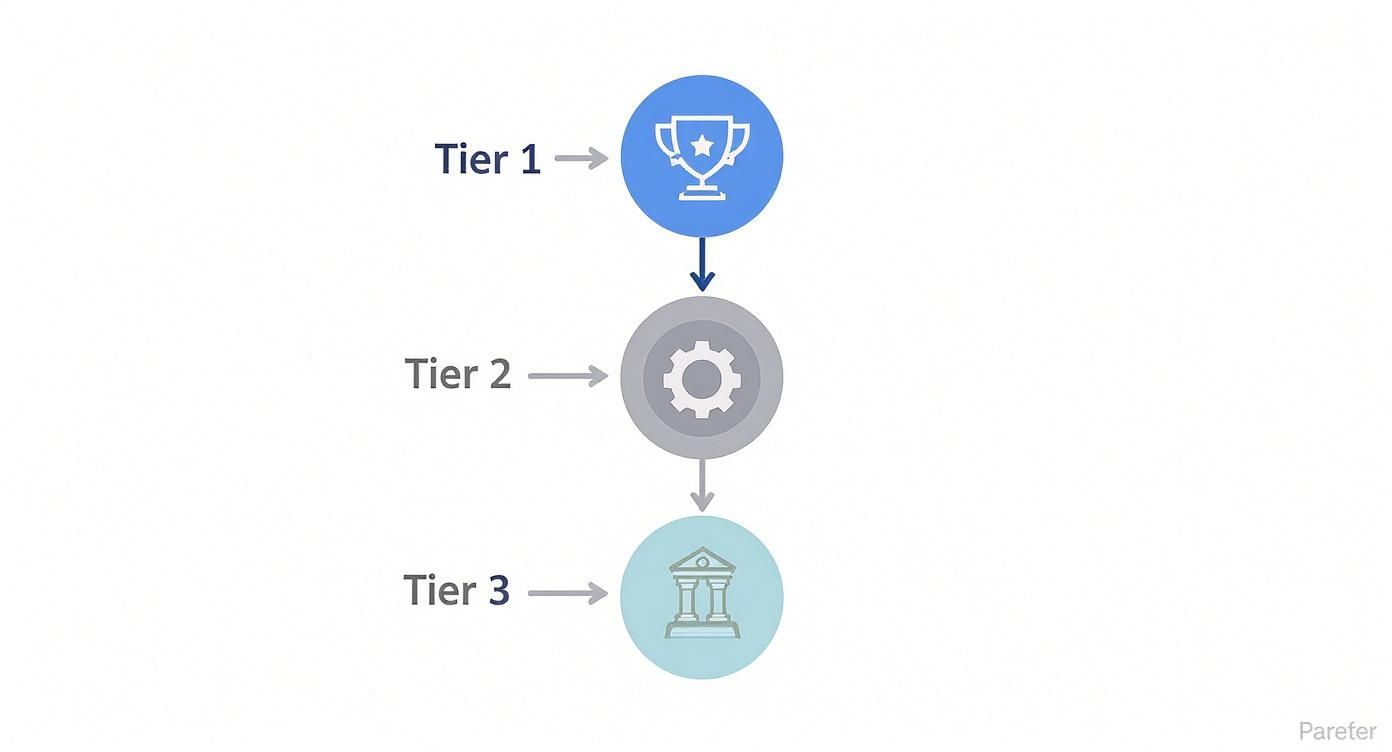
As you can see, each tier props up the layer above it. The goal is to channel all that power into your main website.
The Significant Benefits of a Tiered Strategy
When done correctly, a tiered link building campaign delivers results that are hard to achieve with direct linking alone. It’s a method built for amplification.
The biggest win is turbocharged link equity. A powerful Tier 1 link is great. But when supported by a network of relevant Tier 2 links, its authority gets a massive boost. You make your best backlinks work much harder.
This approach also helps you sculpt a more diverse and natural link profile. By building different kinds of links across your tiers—from guest posts to forum comments—your overall profile looks less manufactured to search engines.
Other key advantages include:
- Improved Cost-Effectiveness: Top-tier links are expensive. Supporting them with cheaper Tier 2 and Tier 3 links maximizes the ROI on your most important assets.
- Controlled Risk Mitigation: The tiers act as a buffer. By keeping lower-quality links on Tier 2 or 3, you insulate your money site from direct association, lowering the odds of a penalty.
- Greater Strategic Flexibility: The layered structure is a perfect sandbox for experimentation. You can test different link types on lower tiers without putting your main domain in jeopardy.
The core reward of tiered link building is squeezing maximum value from every link. As one SEO consultant says, “a rising tide raises all ships.” When you strengthen the sites linking to you, the benefits pass on to your page.
Understanding the Potential Downsides and Penalties
While the benefits are great, the risks are serious. The line between a clever gray-hat strategy and a black-hat link scheme is thin, and crossing it can lead to severe Google penalties.
The main danger comes from Google’s stance against manipulative link building. Their guidelines state that “any links intended to manipulate PageRank… may be considered part of a link scheme.” Since tiered link building is designed to do exactly that, you operate in a gray area from the start.
Today’s algorithms can spot unnatural patterns. A sudden flood of new links to one of your Tier 1 pages is a red flag, especially if they come from low-quality sources. A study of 518 SEO professionals revealed that 91.9% believe their competitors buy backlinks, showing how common these tactics are—and how closely Google is watching.
The most common mistakes that trigger penalties include:
- Building links too quickly without natural growth.
- Using low-quality, spammy sites for Tier 2 and Tier 3.
- Leaving an obvious footprint with the same anchor text or site types.
If Google catches on, the consequences can be brutal. You could see your links devalued or get hit with a manual action that tanks your rankings.
A Modern Guide to Safe Implementation
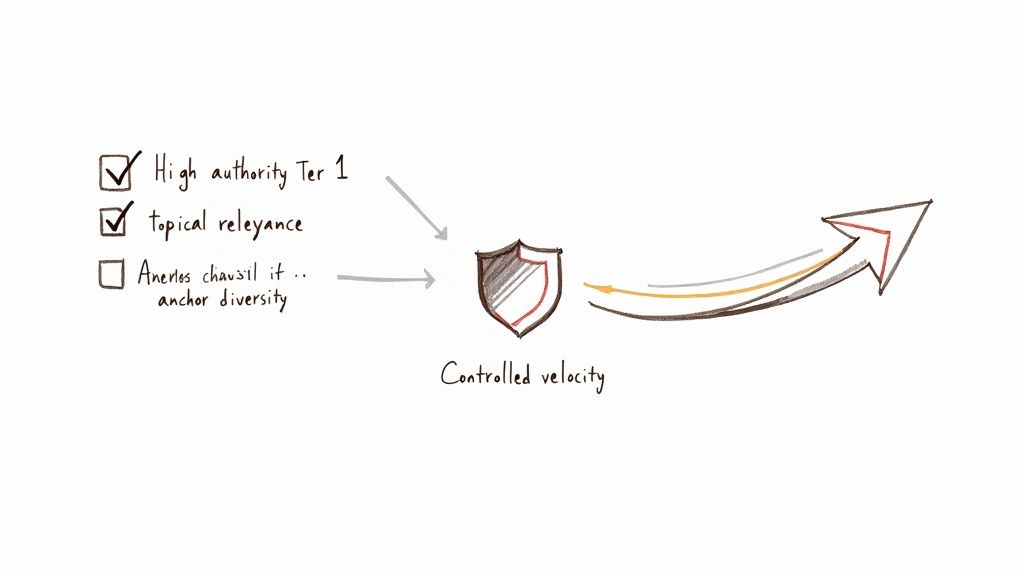
To run a safe tiered link building campaign, you must abandon the old spammy mindset. The modern approach is about quality, relevance, and careful pacing—not blasting thousands of junk links. It’s about strategically amplifying your best assets.
A safe campaign requires meticulous execution. Every step, from choosing Tier 1 targets to diversifying Tier 2 links, must be deliberate. By focusing on a structure that looks natural and authoritative, you can use this strategy’s power while staying within search engine guidelines.
Prioritizing Tier 1 Quality Above All Else
The foundation of a legitimate tiered link building strategy is an unshakeable commitment to Tier 1 quality. These links point directly at your website and must be spotless. Each Tier 1 link should be one you’d be proud of even without building other tiers.
Think of them as flagship placements—digital PR wins or high-authority guest posts on respected blogs. They must come from sites with real traffic, genuine authority, and tough editorial standards. If a Tier 1 link looks sketchy, the entire pyramid built on it is compromised.
Your Tier 1 links are your primary assets. The entire purpose of the lower tiers is to make these high-quality links even more powerful. Never compromise on this first layer.
Building a Diverse and Natural Tier 2
Once you have stellar Tier 1 links, support them with a natural-looking Tier 2. The key word is diversity. Using only one type of link for Tier 2 (like only Web 2.0s) creates an obvious footprint that search engines can easily spot.
Instead, build a varied portfolio of supporting links. A healthy Tier 2 might include:
- Well-written guest posts on mid-tier blogs in your niche.
- Relevant comments in active, moderated industry forums.
- Thoughtful profiles on platforms like Medium or Quora that link to your Tier 1 content.
- Niche-relevant blog comments on articles related to your Tier 1 page’s topic.
This mix makes the backlink profile for your Tier 1 page look organic and earned.
Thematic Relevance Across All Tiers
Maintaining thematic relevance throughout the structure is critical for safety. The topic of your Tier 2 page must relate to your Tier 1 page, which must be relevant to your main site. A break in this chain sends a confusing, potentially spammy, signal to search engines.
For instance, if your money site is about “project management software,” your Tier 1 link should be on a tech or business blog. Your Tier 2 links should then come from articles or forums discussing productivity, team collaboration, or software reviews. This thematic thread reinforces the authority of each link as it passes value up the pyramid.
Smart Anchor Text Diversification
Aggressive, exact-match anchor text is a major red flag, especially in a tiered structure. Over-optimizing anchors at any level is asking for a penalty. The key is diversification and natural language.
Follow these best practices:
- Tier 1 Anchors: Keep these highly varied. Use a mix of your target keyword, branded anchors (your company name), naked URLs, and generic phrases like “click here.” The anchor text should always read naturally.
- Tier 2 Anchors: You have more room to be direct here, but still prioritize natural language. Use topical phrases, the Tier 1 article title, or the website’s name where it was published.
Controlling Link Velocity
How fast you build links—your link velocity—is as important as their quality. A sudden, massive spike in backlinks to a Tier 1 page looks unnatural. A safe campaign mimics organic link acquisition.
Build links gradually over weeks and months, not all at once. Start slowly and steadily increase the volume, allowing the link profile to mature. This patient approach is crucial for staying under the radar of penalty-triggering algorithms.
The growing investment in quality reflects this. By 2025, the average price for a single high-quality backlink has climbed to $508. In parallel, digital PR efforts can yield an average link value between $750 and $1,500, showing that quality-driven tactics provide superior returns. Explore more data on backlink value in the full link building statistics on RockingWeb.
How to Measure Your Campaign’s Impact
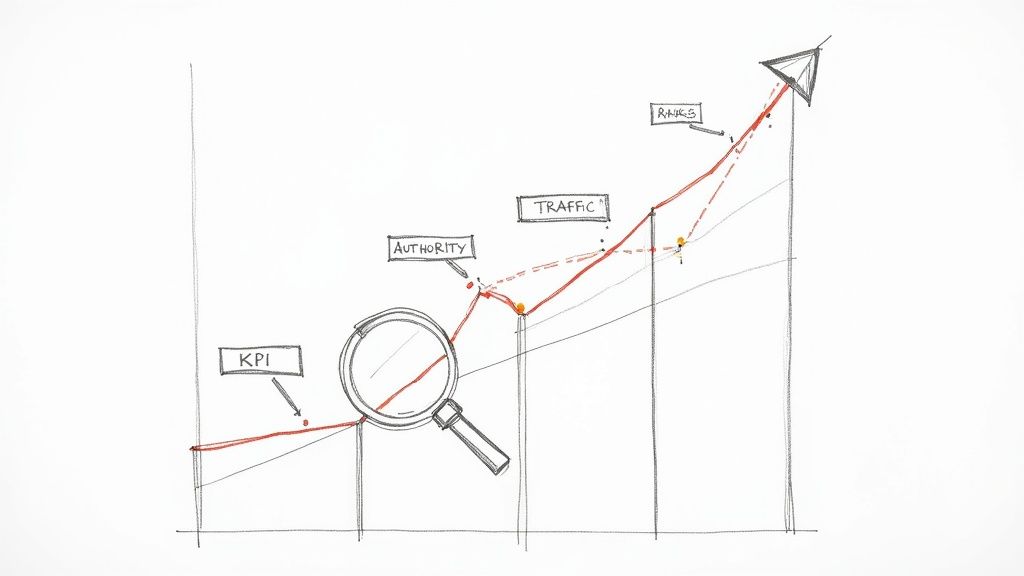
If you can’t measure your tiered link building, you can’t prove it’s working. Without tracking the right key performance indicators (KPIs), you’re flying blind. You have no way to show the value of your work or find ways to improve.
Measuring impact is about connecting your actions to real business results. This is how you demonstrate return on investment (ROI) and justify the resources used, turning a complex link pyramid into tangible traffic and rankings.
Core KPIs for Your Money Site
The most important metrics are tied to your main website. These KPIs tell you if the link equity you’re building is making a difference.
Keep a close eye on these critical metrics:
- Organic Keyword Rankings: Are you climbing the search results for your target keywords? This is the most direct signal of success.
- Organic Traffic Growth: Use a tool like Google Analytics to watch for an increase in unpaid visitors to your key pages.
- Authority Metric Improvements: Look at third-party scores like Domain Rating (DR) from Ahrefs or Domain Authority (DA) from Moz. When these rise, it suggests your site’s overall authority is growing.
These are your north-star metrics. They give you the final verdict on whether the effort is paying off.
The point of tiered link building isn’t just to get links; it’s to improve your website’s performance. If your rankings and traffic aren’t moving up, the campaign isn’t working.
Tracking the Health of Your Tiers
It’s not enough to just watch your money site. You must also monitor the links within your tiers to see how authority is flowing and spot problems early. If your lower-tier links aren’t indexed, they pass no value.
Here’s what to track for your tiers:
- Link Indexation: Confirm that Google has found and indexed your Tier 2 and Tier 3 links. An unindexed link is useless. Use a tool that can check the index status of URLs in bulk.
- Tier 1 Authority Growth: Pay attention to the authority scores (DR, DA) of your Tier 1 pages. As your Tier 2 links take effect, you should see these scores increase. This is a great leading indicator that more value is about to reach your money site.
This detailed tracking ensures every layer of your link pyramid is solid, preventing you from wasting time and money on links that do nothing.
Frequently Asked Questions
Tiered link building is a nuanced strategy, so it’s natural to have questions. Let’s tackle some of the most common ones.
Is Tiered Link Building Still Effective?
Yes, but not like it used to be. The old method of blasting thousands of spammy, automated links at your tiers is dead and will get you penalized.
The modern, effective approach is about quality and strategic amplification. The core idea—making your best backlinks stronger—is more powerful than ever. When done right, you build a network of authority that search engines see as natural and trustworthy. Success today depends on using high-quality, relevant links at every level.
What Is the Difference Between Tier 1 and Tier 2 Links?
The biggest differences are their target and quality standards. They have two different but complementary jobs.
- Tier 1 Links: These are your all-stars. They are the highest-quality backlinks pointing directly to your main website (your “money site”). Think of guest posts on A-list blogs or genuine mentions in news articles.
- Tier 2 Links: These are the supporting cast. They point to your Tier 1 pages, not your main site. Their only job is to pass more authority to your Tier 1 assets, making them more influential. While still relevant, the quality standard is more flexible—think well-written posts on Web 2.0 platforms or contextual links from niche forums.
This separation of duties makes the structure effective and safe.
How Can I Avoid a Google Penalty?
In theory, it’s simple: focus on quality over quantity, always. Your entire link structure must look like it grew organically over time.
Your Tier 1 links are the most critical piece; they must be on reputable sites and feel editorially earned. From there, make the entire profile look natural. This means diversifying your anchor text, using different link types, and building them at a believable pace. Aggressive tactics are a huge red flag for Google.
The tiered structure itself is your best defense. By keeping riskier or lower-quality links on Tier 2 or 3, you create a buffer. This insulates your money site from any negative association if a lower-tier link gets devalued.
What Types of Links Are Best for Lower Tiers?
For Tiers 2 and 3, your goal is a diverse supporting network that doesn’t look like a link scheme. Variety is key.
Good options for Tier 2 include:
- Mid-Tier Guest Posts: Articles on relevant blogs that are good but not top-tier.
- Quality Web 2.0s: Well-crafted articles on platforms like Medium or Blogger.
- Niche Forum Links: Helpful comments in relevant online communities with a natural link.
For Tier 3, the focus shifts to volume and getting Tier 2 links indexed. Common sources are:
- Blog Comments: Relevant, non-spammy comments.
- Social Bookmarks: Submissions to various bookmarking sites.
- Directory Listings: Placements in niche-specific, reputable directories.
Is Tiered Link Building a White Hat or Black Hat Strategy?
It lives in the murky middle ground of gray hat SEO. It isn’t pure white hat because building links to your links is a deliberate attempt to manipulate search rankings.
But it’s not strictly black hat either, especially with a modern, quality-first approach. When you use high-quality Tier 1 links and relevant lower tiers, you operate in a much safer gray area. The strategy becomes black hat when you use automated software to generate thousands of junk links, which is extremely risky.
Are There Safer Alternatives to This Strategy?
Absolutely. If tiered link building feels too risky for your brand, there are plenty of powerful white hat strategies that build authority just as effectively, though differently.
These alternatives focus on creating value and earning links organically:
- Create Link-Worthy Content: Develop original research, comprehensive guides, or free tools that become the go-to resource in your industry. People will link to them without you asking.
- Digital PR Campaigns: Pitch unique stories and expert commentary to journalists and publications to earn high-authority media mentions.
- Strategic Guest Blogging: Focus on writing genuinely helpful articles for top-tier, reputable sites in your niche.
- Relationship-Based Link Building: Build real connections with editors, influencers, and site owners. These relationships naturally lead to linking opportunities over time.
These methods are generally safer, more sustainable, and build a backlink profile that can withstand any algorithm update.
Tired of the endless grind of manual outreach and expensive agencies? BlazeHive uses intelligent AI to automate your entire link-building process. Our platform connects you with relevant websites in your niche for quality backlink exchanges, saving you time and money. Discover a smarter way to build authority at https://www.blazehive.io.

